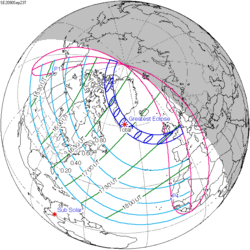| Total eclipse | |
| Gamma | −0.3517 |
|---|---|
| Magnitude | 1.0231 |
| Maximum eclipse | |
| Duration | 116 s (1 min 56 s) |
| Coordinates | 33°06′S76°12′E / 33.1°S 76.2°E |
| Max. width of band | 84 km (52 mi) |
| Times (UTC) | |
| Greatest eclipse | 5:59:18 |
| References | |
| Saros | 142 (19 of 72) |
| Catalog # (SE5000) | 9395 |
A total solar eclipse occurred at the Moon's descending node of orbit on Monday, November 1, 1948, [1] with a magnitude of 1.0231. A solar eclipse occurs when the Moon passes between Earth and the Sun, thereby totally or partly obscuring the image of the Sun for a viewer on Earth. A total solar eclipse occurs when the Moon's apparent diameter is larger than the Sun's, blocking all direct sunlight, turning day into darkness. Totality occurs in a narrow path across Earth's surface, with the partial solar eclipse visible over a surrounding region thousands of kilometres wide. Occurring about 2.4 days after perigee (on October 29, 1948, at 21:20 UTC), the Moon's apparent diameter was larger. [2]
Contents
- Eclipse details
- Eclipse season
- Related eclipses
- Eclipses in 1948
- Metonic
- Tzolkinex
- Half-Saros
- Tritos
- Solar Saros 142
- Inex
- Triad
- Solar eclipses of 1946–1949
- Saros 142
- Metonic series
- Tritos series
- Inex series
- Notes
- References
Totality was visible from Belgian Congo (today's DR Congo), Uganda Protectorate (today's Uganda) including the capital city Kampala, British Kenya (today's Kenya) including the capital city Nairobi, British Seychelles (today's Seychelles), and British Mauritius (today's Mauritius). A partial eclipse was visible for parts of East Africa, Southern Africa, Antarctica, and Australia.
During this eclipse, comet C/1948 V1, also known as the Eclipse Comet of 1948, was discovered shining near the Sun. [3]

































































































